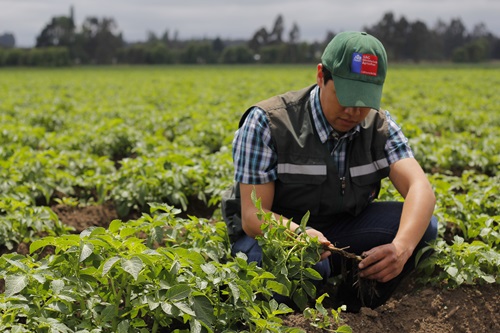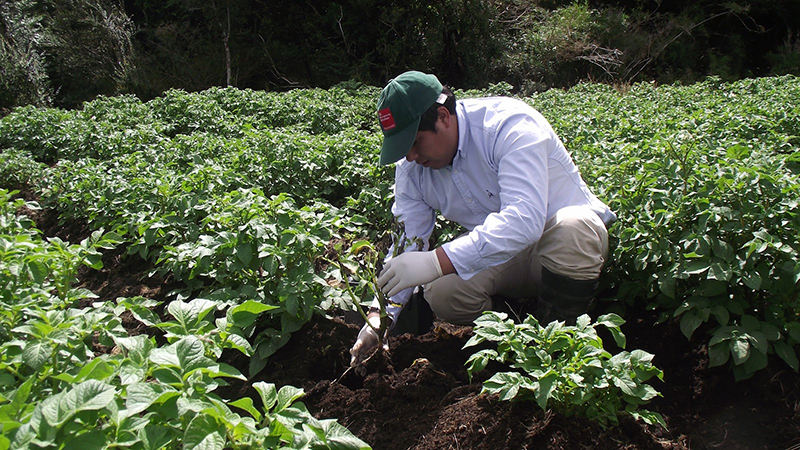A variety is defined as a cultivar that has specific characteristics that can be distinguished from other cultivars of the same species and that are maintained over time. The varieties are differentiated by their morphological characteristics and their genetic material (DNA), duration of the productive cycle, resistance to diseases, nutritional requirements, agronomic characteristics and type of commercial use.

When we refer to agronomic characteristics, it corresponds to the attributes or specific aspects related to the production capacity, adaptive capacity and resistance to biotic and abiotic factors of plants, which constitute differentiating elements.
The commercial characteristics are those that have an impact on the commercialization of the product, including aspects such as: skin color, size or caliber, shape and use of the tuber.
NEW VARIETIES
The introduction of commercial potato varieties from the breeding centers responds to the need to deliver, in the medium and short term, those that adapt to the ecological conditions of the area and the possibility of establishing them in different agricultural areas.
For the introduction of new potato varieties in the productive environment, the following factors should be considered:
- market acceptance (considers skin and pulp color, shape, flavor, others);
- destination of production (potato primor, for storage or agro-industrial processing);
- agronomic characteristics (potential for yield and adaptation in the production area);
- and, sanitary characteristics (level of resistance to serious diseases and pests).
In this sense, to improve the possibility of adopting new varieties, it is necessary to evaluate them in the area where they will be introduced and in this way know their local behavior.
COAST
In the area of Family Farming (AF) of the Coastal Araucanía territory, potatoes are grown for the fresh market, with most of the crops grown under rainfed conditions. In this context, the information provided in this article reflects the production characteristics of commercial potato varieties, in an area where the yield and quality associated with the size of the tubers depend mainly on rainfall. In addition, it is based on evaluations carried out for potato seed production, during three seasons (2017 to 2020) at the INIA Regional Potato Center in Tranapuente, Carahue commune, under rainfed conditions.
YIELDS

Agronomic management was recommended for seed production, being very similar during the three seasons, both in fertilization and in pest and disease control. Nitrogen fertilization fluctuated between 100 and 120 units (kg N / ha); phosphorus between 345 and 350 units (kg P2O5 / ha) and potassium between 120 and 150 units (kg K2O / ha), using a population of 66,600 plants / ha. The evaluations were carried out for seed production, therefore the growth of the crop stopped between 105 and 110 days after planting by means of chemical drying.
The best yield was presented by the Patagonia INIA and Puyehue INIA varieties with 47,004 and 46,216 kg / ha, very similar to each other. Although the yield of the Désirée and Karu INIA varieties is lower, the average of the three years presented results above 41,000 kg / ha, values considered adequate for a crop destined for seed production, since being a shorter cycle the expression of the yield for consumption is limited. Above all, considering that the evaluations were under rainfed conditions.
The Désirée variety, considered as a benchmark for varieties grown in Chile, presents an acceptable total yield for seed production. In this sense, according to the opinion of the producers, in recent years this variety has shown a loss of its yield and quality potential, reflected in the distribution of the sizes produced (size of the tubers). This three-year evaluation would indicate that when certified seed is used, Désirée produces yields very similar or close to those obtained with the improved varieties.
CALIBER DISTRIBUTION
Another factor to consider is the distribution of the caliber produced, associated with quality. In potatoes, it is desirable that the crop concentrates the greatest amount of production in commercial sizes, depending on the destination of the product. Thus, in seed production, we seek to obtain medium to large sizes, while larger sizes are preferred for consumer potatoes. In this sense, higher seed populations are used to produce seed, in such a way that the growth competition between tubers limits the production of large sizes or over sizes. The regulation of the seed law for commercialization is distributed in four sizes: 25-35 mm; 35-45 mm; 45-55 mm and 55-65 mm. Small potatoes smaller than 25 mm are considered waste, while those larger than 65 mm are classified as oversize.
Regarding the above, the Désirée variety presented the largest small sizes, both in waste and in seed (25-35 mm). For the same calibers, the varieties Karu INIA, Puyehue INIA and Patagonia INIA presented lower values, very similar between them. Similarly, Désirée presented the highest value of caliber 35-45 (24.6%). When observing the medium to large seed sizes, it stands out that the Karu INIA, Puyehue INIA and Patagonia INIA varieties have very similar participation percentages, with Puyehue INIA standing out, presenting 27.2% in the 45-55 size and only 4% in the envelope. caliber.
On the contrary, the Patagonia INIA variety, followed by Karu INIA, showed the highest percentages of over size compared to the total harvested productivity, with 19.2% and 17.7% respectively; and, the Désirée variety presented a lower level.
Considering the results of this work, originated under the umbrella of the GORE-INIA program “Technological innovation applied to productive processes of the Regional Potato Center, to strengthen the competitiveness of the coastal territory of the Region of La Araucanía” and which is executed by INIA Carillanca, together with the municipalities that make up the Tranapuente Agreement and financed by the Regional Government, it was concluded that the 4 varieties evaluated presented adequate yields as seed potatoes under rainfed conditions.

